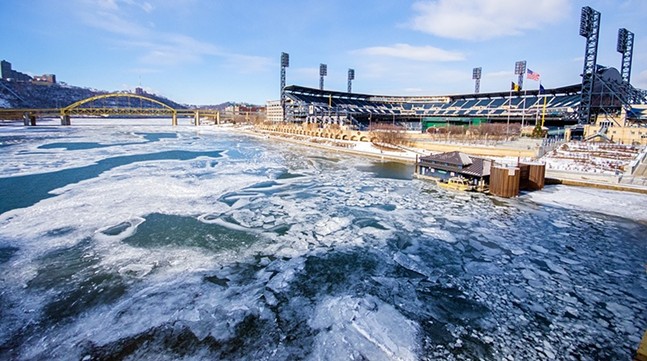It takes a lot of cold to freeze one river, let alone three. But the frigid temperatures that have hung over Pittsburgh for the last couple weeks have accomplished just that. Many sections of the Allegheny, Monongahela and Ohio rivers have accumulated inches of ice. (Check out this week's City Paper out Jan. 10 for more spectacular images of our iced-over rivers.)
Lee Hendricks, a hydrologist at the Pittsburgh branch of the National Weather Service, says that some parts of the Allegheny and Mon rivers have accumulated up to 5 inches of ice.
“On the Allegheny River near Natrona Heights, it’s 100 percent ice covered with 2 to 5 inches in places,” says Hendricks.
And although temperatures have already risen significantly in the Pittsburgh region, and are due to rise even higher this week (up to 55 degrees on Jan. 11), Hendricks says the ice won't rapidly dissipate.
“The 1-to-2-inch-thick ice will begin to rot and slowly move out,” says Hendricks. “But the thicker ice, we are not really expecting it to be gone quickly. Right now, it is looking like it will take time for all of the ice to move out.”
Hendricks says a gradual decrease of ice is better for the boats that have to navigate Pittsburgh’s rivers. (He notes that some boats recently got stuck on the Ohio River near the Sewickley Bridge.) But, Hendricks says if, for instance, there was heavy rain this week, that could cause the water levels of the rivers to rise and upend huge chunks of ice. That moving ice could be dangerous to barges and other watercraft that use the three rivers.
Luckily, Hendricks says, though the forecast calls for rain later in the week, and it shouldn’t be heavy enough to cause dangerous slabs of ice to flow downstream. This means the ice will stick around for a while.
So if you’ve procrastinated or have been too busy, you still have time to check out the ice floating on top of Pittsburgh’s famous waterways. But, as Hendricks points out, don’t walk on the ice, not matter how thick. He says that when rivers freeze, the ice thickness varies and it's difficult to predict how thin it is at many points.
“We don't want people walking out on the ice. It is dangerous,” says Hendricks. “Ice on a lake is one thing, but ice on a moving body of water like a river is a totally different animal.”


